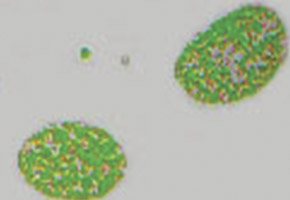

A study financed by FAPESP reveals how a drug used in epilepsy treatment affects chromatin, a structure that regulates global gene expression and is essential for cellular processes. The study was published in PLoS One
A study financed by FAPESP reveals how a drug used in epilepsy treatment affects chromatin, a structure that regulates global gene expression and is essential for cellular processes. The study was published in PLoS One.
A study financed by FAPESP reveals how a drug used in epilepsy treatment affects chromatin, a structure that regulates global gene expression and is essential for cellular processes. The study was published in PLoS One.

A study financed by FAPESP reveals how a drug used in epilepsy treatment affects chromatin, a structure that regulates global gene expression and is essential for cellular processes. The study was published in PLoS One
By Fábio de Castro
Agência FAPESP – Valproic acid, a drug widely used to treat epileptic episodes, affects epigenetic markers on DNA, causing significant changes in chromatin structure, which regulates several essential cellular functions.
Scientists from Universidade Estadual de Campinas (UNICAMP) made the discovery, recently published in PLoS One. The study was conducted under the auspices of a Thematic Project financed by FAPESP and coordinated by Maria Luiza Silveira Mello, of the UNICAMP Department of Cellular and Structural Biology.
“According to its most recent definition, epigenetics is the study of any factor that changes gene expression or cell phenotype and is potentially stable and likely to be inherited but does not change the sequence of DNA bases,” explains Mello.
Performed through image analysis of cell cultures, the study was the master’s research project of FAPESP fellow Marina Felisbino, conducted through UNICAMP’s Cellular and Structural Biology Program under Mello’s guidance. The article, published in PLoS One, also features contributions from Wirla Tamashiro, a professor in the Department of Genetics, Evolution and Bioagents at UNICAMP’s Institute of Biology.
According to Mello, the Thematic Project is focused on basic science, and one of its main objectives is to help understand how epigenetic markers can cause structural alterations in chromatin. The study in question showed that valproic acid has a major inhibitive effect on histone deacetylase and also affects DNA methyltransferase activity.
“The international literature shows that epigenetic markers deregulate 6% of genes in certain cells. In affecting these epigenetic markers, valproic acid induces a structural remodeling of chromatin,” Mello explains in an interview with Agência FAPESP.
Chromatin is a structure present in every cell that has a nucleus. The chromatin contains genomic DNA – the seat of genetic information – in a complex with proteins that include histones, non-histone proteins and possibly small RNAs.
“When a cell is not dividing, we call this material chromatin. When the cell is dividing, we call it a chromosome,” explains Mello. Epigenetics has proven crucial in explaining the regulation of genomic DNA.
All of the cells in every tissue of an organism contain identical DNA. However, although it contains all of the information required for every cell function, the genomic DNA does not determine all the characteristics that the cell will have. Thanks to genetic regulation, only some of this information is expressed in each cell, allowing each cell type to acquire its specific properties and carry out its unique functions.
“This regulation is controlled by epigenetic markers, which can be on the DNA or in the proteins in the cell’s nucleus. Epigenetic markers allow the DNA of every cell to contain the same information but be expressed differentially. One type of epigenetic change occurs through a chemical modification of the DNA known as the process of methylation of cytosines, which are one of the four DNA bases,” affirms Mello.
Cytosine methylation is catalyzed by enzymes known as DNA methyltransferases. “There are other modifications that also occur in histones. The most important are the addition and subtraction of diverse chemical groupings. For example, in the case of histones, the addition of acetyl groups is catalyzed by histone acetyltransferases,” she explained.
Decondensation of chromatin
To understand the role of epigenetic markers on chromatin structure, researchers often utilize agents or drugs that alter the activities of DNA methylation-catalyzing enzymes. “In this context, we discovered that valproic acid, a well-known and widely used anticonvulsive drug used in the treatment of epilepsy, acts on cells as an inhibitor of histone deacetylase enzymes,” says Mello.
An international group has shown that when HeLa cells – tumor cells that are widely used in laboratory settings – are treated with valproic acid, 6% of the genes are deregulated.
“Our contribution consisted of image analyses showing that valproic acid, in acting as a histone deacetylase inhibitor, induces the structural remodeling of chromatin, causing decondensation,” says Mello.
“The drug inhibits histone deacetylases, which are enzymes that catalyze the removal of acetyl groups from histones. These inhibited enzymes no longer function, and the histones remain acetylated instead of becoming deacetylated. Because of this, the chromatin is ‘weaker.’ Some genes that should become active do not, and vice versa, causing the genetic deregulation that had been observed,” she explained.
The article Chromatin remodeling, cell proliferation and cell death in valproic acid-treated HeLa cells (doi:10.1371/journal.pone.0029144) by Maria Luiza Silveira Mello, Wirla Tamashiro and Marina Felisbino, can be read at www.plosone.org/article/info%3Adoi%2F10.1371%2Fjournal.pone.0029144.
Republish
The Agency FAPESP licenses news via Creative Commons (CC-BY-NC-ND) so that they can be republished free of charge and in a simple way by other digital or printed vehicles. Agência FAPESP must be credited as the source of the content being republished and the name of the reporter (if any) must be attributed. Using the HMTL button below allows compliance with these rules, detailed in Digital Republishing Policy FAPESP.





